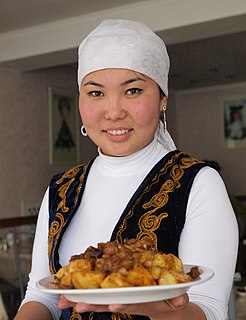 W
WKyrgyz cuisine is the cuisine of the Kyrgyz, who comprise a majority of the population of Kyrgyzstan. The cuisine is similar in many aspects to that of their neighbors.
 W
WBeshbarmak is a dish from Central Asian cuisine. It is also known as naryn in Xinjiang, Uzbekistan, Kyrgyzstan and Kazakhstan, as turama or dograma in Karakalpakstan, North Caucasus and Turkmenistan, as kullama in Bashkortostan and Tatarstan. It is a national dish of Kyrgyzstan and Kazakhstan.
 W
WBoortsog or bawïrsaq is a type of fried dough food found in the cuisines of Central Asia, Idel-Ural, Mongolia and the Middle East. It is shaped into either triangles or sometimes spheres. The dough consists of flour, yeast, milk, eggs, margarine, salt, sugar, and fat. Tajik boortsog are often decorated with a criss-cross pattern by pressing the bottom of a small strainer on the dough before it is fried.
 W
WÇäkçäk, frequently anglicized as chak-chak, is a Tatar sweet. It is particularly popular in Tatarstan and Bashkortostan, and is recognized as Tatarstan's national sweet in Russia.
 W
WChorba or shorba, refers to several kinds of soup or stew found in national cuisines across the Balkans, Central Europe, Eastern Europe, Central Asia, Middle East and the Indian subcontinent. It is often prepared with added ingredients but served alone as a broth or with bread.
 W
WA dastarkhwān or dastarkhān, is the name used across Central Asia, South Asia and the Caribbean to refer to the traditional space where food is eaten. The term may refer to the tablecloth which is spread on the ground, floor, or table and is used as a sanitary surface for food, but it is also used more broadly to refer to the entire meal setting. The Mughal Indian cookbook Dastarkhwan-e-Awadh, which details the Awadhi cuisine of Lucknow, emphasized the importance of the dastarkhwan.
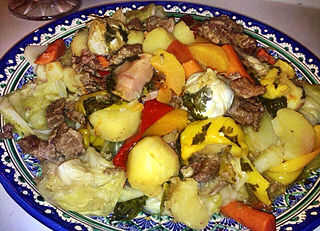 W
WDimlama or dymdama is a Turkic and Tajik or more broadly Central Asian, stew made with various combinations of meat, potatoes, onions, vegetables, and sometimes fruits. Meat and vegetables are cut into large pieces and placed in layers in a tightly sealed pot to simmer slowly in their own juices. Vegetables for dimlama may include, in addition to potatoes and onions, carrots, cabbage, eggplants, tomatoes, sweet peppers, spiced with garlic and a variety of herbs and condiments. Dimlama is usually cooked during spring and summer when there is a wide choice of vegetables. It is served on a large plate and eaten with a spoon.
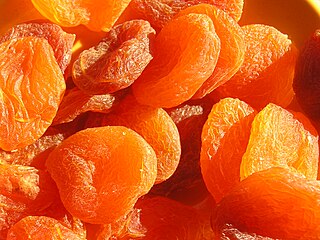 W
WDried apricots are a type of traditional dried fruit. When treated with sulfur dioxide (E220), the color is vivid orange. Organic fruit not treated with sulfur vapor is darker in color and has a coarser texture. Generally, the lighter the color, the higher the SO2 content.
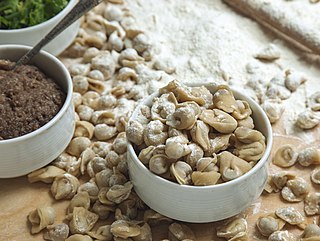 W
WJoshpara is a kind of dumplings popular in Central Asia, South Caucasus and the Middle East. They are made of unleavened wheat dough squares filled with ground meat and condiments. In observance of the Islamic dietary rules, the meat filling is usually without pork.
 W
WKashk or qurut is a range of dairy products used in cuisines of Iranian, Afghan, Turkish, Kurdish, Mongolian, Central Asian, Transcaucasian and the Levantine people. Kashk is made from drained yogurt or drained sour milk by shaping it and letting it dry. It can be made in a variety of forms, like rolled into balls, sliced into strips, and formed into chunks.
 W
WKaymak, Sarshir, or Qashta/Ashta is a creamy dairy food similar to clotted cream, made from the milk of water buffalo, cows, sheep, or goats in Central Asia, some Balkan countries, some Caucasus countries, the countries of the Levant, Turkic regions, Iran and Iraq. In Poland, the name kajmak refers to a confection similar to dulce de leche instead.
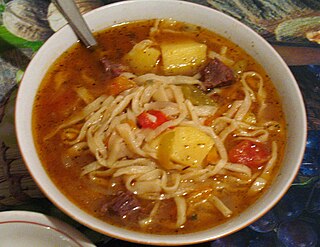 W
WKesme or erişte is a type of egg noodle found in various Turkic countries, Iran and Afghanistan. It is also found in Turkish cuisine and is called erişte and “kesme” in modern standard Turkish. The word itself is a nominalisation of the verb to cut or to slice, referring to the slicing of the dough involved in preparing the noodles. The term may refer to the noodles themselves, or the prepared dish made with them. Kesme is traditionally a homemade dish, and not often found at restaurants or cafés. In Turkey, kesme is also known as "erişte", and eaten generally in winter. It is made from flour, egg, water, salt and milk. These ingredients are worked into a dough, which is rolled out, cut, and dried in the sun or an oven after dried for a day.
 W
WKumis Mongolian: айраг, ääryg) is a fermented dairy product traditionally made from mare's milk or donkey milk. The drink remains important to the peoples of the Central Asian steppes, of Turkic and Mongol origin: Kazakhs, Bashkirs, Kalmyks, Kyrgyz, Mongols, and Sakha. Kumis was historically consumed by the Khitan, Jurchen, Hungarians and Han Chinese of North China as well.
 W
WKuurdak, transliterated with various spellings, is a traditional meat dish made in Central Asia. The name comes from a nominalisation of the word "roast", "fried", referring to how the food is made. It is described as "stewed brown meat".
 W
WLaghman is dish of meat, vegetables and pulled noodles from Central Asian cuisine. The noodle is known as latiaozi in China.
 W
WLavash is a thin flatbread usually leavened, traditionally baked in a tandoor (tonir) or on a sajj, and common to the cuisines of South Caucasus, Western Asia, and the areas surrounding the Caspian Sea. Lavash is one of the most widespread types of bread in Armenia, Azerbaijan, Iran and Turkey. The traditional recipe can be adapted to the modern kitchen by using a griddle or wok instead of the tonir.
 W
WManti is a type of dumpling popular in most Turkic cuisines, as well as in the cuisines of the South Caucasus and Balkans, Central Asia, Afghanistan, Iran, Pakistan, Bukharian Jews and Chinese Muslims. Manti are also consumed throughout Russia and other post-Soviet countries, where the dish spread from the Central Asian republics. The dumplings typically consist of a spiced meat mixture, usually lamb or ground beef, in a thin dough wrapper and either boiled or steamed. Size and shape vary significantly depending on the geographical location. Manti resemble the Chinese jiaozi and baozi, Korean mandu, Mongolian buuz and the Tibetan momo and the dish's name is cognate with the Korean mandu, Chinese mantou and Japanese manjū, although the modern Chinese and Japanese counterparts refer to different dishes.
 W
WNaryn, neryn or norin is a Central Asian dish with horse meat and different kinds of noodles.
 W
WOromo, [oromo]) or Orama is a traditional steamed pie made in Central Asia, especially among the Kyrgyz and the Kazakhs. The name comes from a nominalisation of the word "to roll"/"to wrap", referring to how the food is made.
 W
WPilau or Pilaf is a rice dish, or in some regions, a wheat dish, whose recipe usually involves cooking in stock or broth, adding spices, and other ingredients such as vegetables or meat, and employing some technique for achieving cooked grains that do not adhere.
 W
WQarta is a Kazakh and Kyrgyz cuisine dish of boiled and pan-fried horse rectum, taken from the final few inches of digestive tract before the muscular part of the anus. It is served without sauce or spices. The section includes "strong tissue on the outside" and "gradations of tender mucous membrane tissue and fatty mass on the inside" and includes a layering of soft and hard tissues that dense and varied with fat, according to a reviewer from Vice.com. It is prepared in various ways to clean it thoroughly and remove any unpleasant taste due to the provenance of the tissue. One method is to turn it inside out and wash it thoroughly. It can also be smoked for 24 hours and then (sometimes) dried for an additional 48 hours. Or it can be boiled for a couple of hours. It is then sliced into rounds, simmered in a "meat bouillon" and seasoned with salt, green pepper, and dill. It is often served with qazy.
 W
WKattama, katlama, katmer, or gambir is a fried layered bread common in the cuisines of Central Asia. Qatlama in traditional Turkish means "folded", which comes from the verb qatlamaq "to fold", likely referring to the traditional method of preparation. The Turkish variety katmer is made as a dessert with kaymak and like many other delicacies from Gaziantep, is also filled and topped with pistachios.
 W
WQazı is a traditional sausage-like food of Kazakhs, Tatars, Kyrgyz, Uzbeks and other ethnic groups mainly of Central Asia, particularly those of Turkic origin. Kazy is a common element on a dastarkhan, a table set for a festive meal. Qazy is a dish in Kazakh and Kyrgyz cuisines made from sliced horse rib meat in an intestine casing. A reviewer from Vice (magazine) described the dish as smokey and earthy.
 W
WSamsa is a savoury pastry in Central Asian cuisines. It represents a bun stuffed with meat and sometimes with vegetables.
 W
WShelpek is a traditional Central Asian flatbread commonly consumed all over the region. The main ingredients of shelpek are flour, milk, sugar, butter, sour cream such as Kaymak, baking soda, salt and vegetable oil.
 W
WSujuk or sucuk is a dry, spicy and fermented sausage which is consumed in several Balkan, Middle Eastern and Central Asian cuisines. Sujuk mainly consists of ground meat and animal fat usually obtained from beef or lamb, but horse meat is also often used in Bulgaria, Kazakhstan and Kyrgyzstan.
 W
WA tandoor also known as tannour is predominantly a cylindrical clay or metal oven used in cooking and baking. The tandoor is used for cooking in Southern, Central, and Western Asia, as well as in the South Caucasus.
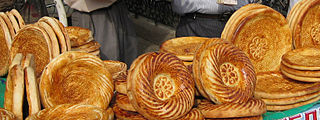 W
WTandyr nan, tandir non (Uzbek) or tonur nan, also called lepyoshka, is a type of Central Asian naan.